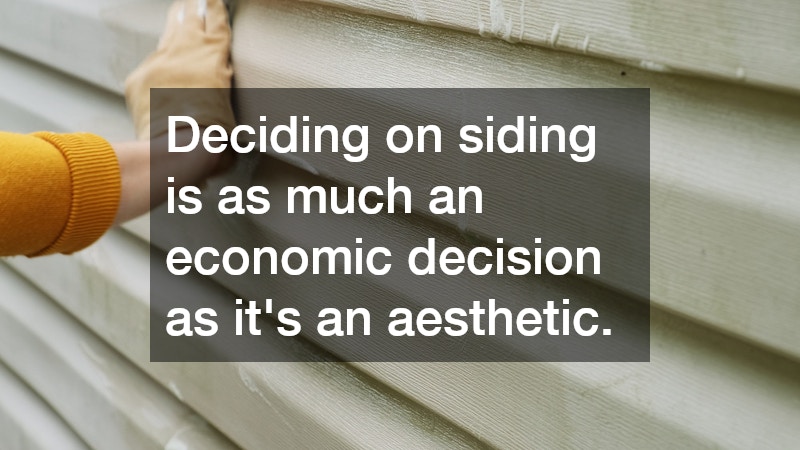Choosing the right siding for your home is a crucial decision. This article aims to help you compare different siding options, making an informed choice that suits your needs and preferences.
What are the Different Types of Siding Options Available?
Vinyl Siding
Vinyl siding is a popular choice for homeowners due to its combination of durability and affordability. It requires minimal maintenance, which is a significant advantage for busy homeowners seeking practical solutions.
This material is resistant to common issues like rot and pests, making it a long-lasting option. Despite its durability, vinyl siding is available in a variety of colors and styles, allowing for customization.
Moreover, its cost-effectiveness is exemplified by its relatively low installation costs compared to other materials. Vinyl siding is an attractive option for those looking to enhance their home within budget constraints.
Wood Siding
Wood siding offers unparalleled aesthetic appeal, contributing to a home’s exterior’s natural beauty and charm. However, it requires regular maintenance, such as staining and sealing, to preserve its appearance.
This material is often considered more environmentally friendly, as it’s biodegradable and derives from renewable resources. Yet, wood siding demands an investment of time and resources to sustain its longevity.
The ability to paint and customize wood siding as desired adds to its appeal. Homeowners often choose wood for its elegance and traditional look despite the higher maintenance requirements.
How Does Siding Affect Energy Efficiency?
Understanding Insulation Properties
Different siding materials provide varying levels of insulation, significantly impacting a home’s energy efficiency. For instance, insulated vinyl siding includes an added layer of thermal resistance, enhancing temperature regulation.
Wood siding, while aesthetically pleasing, doesn’t offer the same insulating properties as some synthetic alternatives. The choice of siding can thus directly contribute to energy savings and reduced utility bills.
Enhancing a home’s insulation through the right siding option is a strategic consideration. Ensuring your siding complements other insulation efforts is key to optimal energy efficiency.
Impact on Heating and Cooling Costs
Investing in the right siding can result in a notable decrease in heating and cooling expenses. Superior insulation properties of specific siding materials help maintain a stable indoor climate.
For example, energy-efficient siding can prevent heat loss in winter and minimize heat gain during summer months. Thus, homeowners can enjoy comfort year-round while experiencing cost savings.
Choosing siding that optimizes energy efficiency benefits your wallet and contributes to a smaller carbon footprint. It’s a win-win for your home and the environment.
Which Siding Material is the Most Durable?
Climate Considerations
Geographical location and climate play pivotal roles in determining the durability of siding materials. Vinyl siding, for instance, holds up well in warmer climates due to its resistance to moisture.
Conversely, homes in colder regions may benefit more from fiber cement siding, which withstands snow and freezing temperatures. Selecting appropriate siding based on local climate conditions is crucial for longevity.
By considering climate, homeowners can prevent preventable wear and tear on their siding. Long-term durability directly correlates with selecting materials suited to their environment.
Resistance to Wear and Tear
When evaluating siding options, resistance to issues like moisture, pests, and UV radiation is essential. Fiber cement siding offers exceptional protection against these elements, making it a reliable choice.
While wood siding is susceptible to moisture damage, vinyl siding exhibits considerable resistance to such wear. Interestingly, the longevity of your siding also depends on proper installation and regular maintenance.
Investing in quality materials and installation pays off in the long run. To extend the lifespan of your home’s exterior, opt for siding that minimizes susceptibility to common threats.
How Do Siding Options Impact Home Value?
Aesthetic Appeal and Curb Appeal
One of the most significant influences of siding on home value is its contribution to curb appeal. A visually appealing exterior can entice potential buyers and enhance a property’s overall marketability.
Both vinyl and wood siding offer diverse customization options that can boost a home’s exterior aesthetics. This visual impact can significantly sway a buyer’s perception and interest in the property.
A seamless blend of style and function in siding can set your home apart from others in the market. Taking advantage of siding’s ability to enhance appearance is a strategic move in real estate.
Return on Investment
The financial aspect of siding cannot be ignored, with installation costs weighed against the potential increase in home value. Vinyl siding often offers a high return on investment due to its balance of affordability and impact on curb appeal.
Wood siding, though more expensive, may deliver significant returns through sheer aesthetic enhancement. Homeowners seeking financial benefits must assess how their siding choice affects overall market value.
Deciding on siding is as much an economic decision as it’s an aesthetic. A well-chosen siding can contribute to a rewarding increase in property valuation.
Siding is a significant investment in your home. By considering factors such as material types, energy efficiency, durability, and impact on home value, you can make a well-informed decision that enhances the beauty and functionality of your home for years to come.




